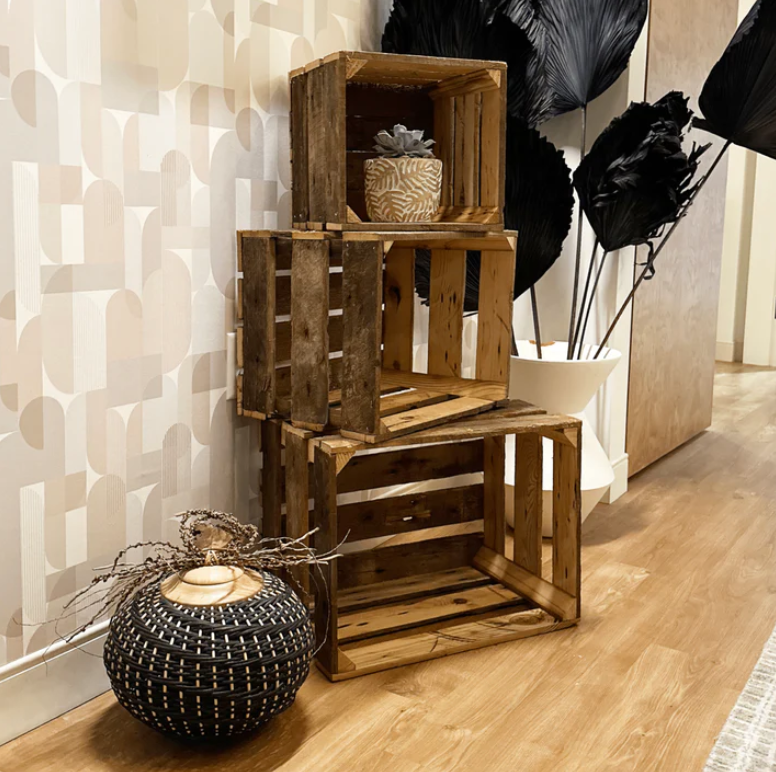The Art of Reclamation: Rediscovering the Beauty and Sustainability of Reclaimed Wood Decor

Introduction to Reclaimed Wood Decor
There is something undeniably timeless and captivating about the warmth and character that reclaimed wood décor, or wood décor in general, can bring in to a space. Recently, reclaimed décor has captured the attention of many professionals within interior design and building community and it has caused an uptick in its various uses. Whether your design style is modern, rustic, industrial, or bohemian, wood décor will blend and compliment any space seamlessly. Reclaimed wood décor specifically carries its own unique story and is a true testament to times past. In this article, we will dive into the world of reclaimed wood décor. We will explore the history or the wood, what makes it unique, the difference between distressed and reclaimed wood, and the best ways to incorporate it into various living spaces and interior design types, and its sustainable benefits.
What is Reclaimed Wood?
Reclaimed wood is the term used to describe wood that has been salvaged from old structures such as barns, farmhouses, or factories and repurposed into new projects. Instead of these buildings being left to rot or these pieces being turned into firewood, this wood is given a second chance at life, preserving its original character and history. Reclaimed wood also serves as an eco-friendly alternative to using newly harvested lumber, which in turn helps reduce the demand for deforestation and helps in minimizing waste. By using reclaimed wood for your décor, flooring, or furniture, you are preserving a one-of-a-kind piece of history and putting it only display in your home while still receiving a high quality, durable product. Reclaimed wood is generally 100-250 years old and carries many characteristics that cannot be replicated.
The Sustainable Benefits of Using Reclaimed Wood
Using reclaimed wood for your décor projects goes beyond simply just updating the aesthetic appeal in your space. It is a conscious choice that helps contribute to the sustainability and preservation of our planet. By choosing reclaimed wood, you are reducing the need to harvest trees which helps minimize the carbon footprint associated with logging and growing new timbers quickly. By choosing reclaimed wood, you are also helping to allow new trees to grow naturally over time and protecting old growth forests with wood species that may be close to extinction. Because many reclaimed materials are left to be as natural as possible, less energy resources go into the manufacturing of reclaimed wood products. Embracing this unique material allows us to not only create beautiful spaces within our homes and offices, but also give us the peace of mind of being environmentally friendly and responsible.
The History and Character of Reclaimed Barnwood
One of the most popular types of reclaimed wood is barn wood. With its rich and deep rooted history, along with its weathered appearance and one-of-a-kind characteristics, will undoubtedly captivate everyone who sees it. Barn wood is typically sourced from old barns, farmhouses, or like structures that have reached the end of their functional life or are no longer needed by their owners. The wood used within these structures has aged and weathered over time giving it a unique texture and patina. Along with characteristics from the woods species, prior use, exposure to the elements, and geographical location, each piece is rare and one of a kind. By incorporating reclaimed barn wood into your home or office décor, it not only adds character and individuality, but also connects you to the past, preserving a piece of history within your own home and adding to your history.
What is the difference between distressed wood and Reclaimed wood?
There are times where you may see wood décor labeled as “distressed” and the wood may look very similar to reclaimed wood. More often than not, in these cases the artisan will take newer wood or non-reclaimed material and distress it/add characteristics to make it look and feel like authentic reclaimed materials. However, this is not the same as authentically reclaimed wood. With authentically reclaimed wood you do not have control over the specifics of the characteristics present within the pieces and do not have a way to lessen or remove them from the pieces being used. Distressed wood is a good option if there are more characteristics that you prefer to stay away from in reclaimed material over then the amount of characteristics that you are drawn to and if you would like to have more control over what characteristics are present or not in the décor.
Incorporating Reclaimed Wood into Your Living Room Decor
The living room is undoubtedly the heart of the home, and it's the perfect place to showcase the beauty of reclaimed wood. Consider using reclaimed wood for your coffee table, a feature wall, shelves, or even as flooring for an upgrade. The natural warmth and texture of the wood will create a cozy and inviting atmosphere regardless of your décor style. Combine it with soft textiles, such as linen or wool and light colors, to enhance the rustic feel and warmth. For a more modern incorporation, natural wood pops and contrasts perfectly with darker colors, grays, and blacks. You can also incorporate reclaimed wood through decorative accents like picture frames, wall art, or serving trays. Don't be afraid to mix and match different wood finishes and colors to add depth and visual interest to your living room decor. Reclaimed wood can also be used to create furniture pieces such as entertainment centers and benches. You have the freedom and flexibility to do as little or as much as you would like!
Using Reclaimed Wood to Create a Rustic Office Space
Bring the appeal of rustic decor into your work environment by incorporating reclaimed wood into any office space. Opt for a reclaimed wood desk with clean lines and a sturdy construction. Pair it with a comfortable chair upholstered in natural fabrics. Consider adding floating shelves made from reclaimed wood to display books, plants, or decorative objects. The combination of natural wood and a clean, minimalist design will create a calming and inspiring workspace. Wanting something a little bit more exciting than shiplap? Use reclaimed wood wall paneling to add depth and intrigue to your walls. Don't forget to add lighting and personal touches to make the space uniquely yours. If your office is more of a showroom space, use shelves to proudly display your products with a little dash of history, reclaimed wood benches for customer seating and visual appeal, or reclaimed wood desks for your showroom associates. The possibilities of reclaimed wood are vast, large, and varied.

Reclaimed Wood Mantels: A Focal Point for Your Fireplace
A reclaimed wood mantel can transform your fireplace into the stunning focal point that captures your attention as soon as you enter the room. The natural beauty and unique grain patterns of reclaimed wood will add both character and warmth to your space. Whether your design style is modern or rustic, there is a reclaimed wood mantel to suit your taste. You can choose a more traditional, characteristic laden design, or a simple, sleek design that touches rustic but leans to be more modern. Pair it with vintage-inspired accessories or contemporary artwork to create a harmonious balance between old and new. A process called skip planning can refine a mantel. This process removes the high points of material on the piece. The results are crisper edges, a slightly smoother to the touch feel, less characteristics overall, and a lighter color. Add a lacquer finish and this mantel could be considered a contemporary option with rustic flair. If you love and appreciate the roughness and specific markings of your mantel, you can add a sealant to strike the perfect balance of keeping the piece as natural as possible while making it a bit more refined. And if rough and rugged is your style, leave it completely as-is and enjoy it in all of its natural glory!
Reclaimed Wood Shelves: Functional and Stylish Storage Solutions
Incorporating reclaimed wood shelves into your decor not only adds a rustic touch but also provides functional storage solutions. These shelves can be used in various rooms, from the kitchen to the bathroom and beyond. Use them to display your favorite dishes, vintage glassware, or potted herbs in the kitchen. In the bathroom, reclaimed wood shelves can hold towels, toiletries, and decorative items. For an alternative use in your living room, use them to create a floating entertainment center. The natural beauty of the wood will elevate the look of any space while providing practical storage options. For other eclectic storage solutions, consider using reclaimed wood crates, open box shelves, or serving trays to display and hold your precious trinkets, records, blankets, and more.
Reclaimed Wood in Interior Design: Tips and Inspiration
When working with reclaimed wood in interior design, there are a few key tips to keep in mind. First, make sure to properly clean and treat the wood before using it in your projects or ensure that it has been properly dried, cleaned, and treated. This will ensure its longevity and protect it from pests or mold. Second, consider the overall style and theme of your space. Reclaimed wood can be incorporated into various design aesthetics, from farmhouse to industrial and everything in between. Consider colorways, textures, lighting, and other décor in the room to ensure your pieces blend in or stick out to meet your vision. Lastly, don't limit yourself to furniture and accents. Reclaimed wood can be used for flooring, wall paneling, ceilings, and furniture, adding a unique touch to your entire space.
Where to Find Reclaimed Wood for Your Decor Projects
Finding reclaimed wood for your decor projects may seem daunting and difficult at first, but there are plenty of sources available. Local salvage yards, architectural salvage stores, or online marketplaces specializing in reclaimed materials are great places to start. You can also connect with local artisans or carpenters who specialize in working with reclaimed wood. They can guide you in sourcing the right materials and help bring your design ideas to life. Remember, each piece of reclaimed wood has its own story to tell, so take the time to find the perfect pieces for your project and be willing to be flexible if needed. To skip this step, look for artisans who already specialize in the material and have an expert take care of it all for you from sourcing to prepping and finishing for use.

Conclusion: Embracing the Beauty and Sustainability of Reclaimed Wood Decor
In conclusion, reclaimed wood decor offers a truly unique blend of beauty, history, and sustainability. By incorporating reclaimed wood into our living spaces, we not only create visually stunning environments but also contribute to the preservation of our planet. From the warmth of reclaimed barnwood to the versatility and functionality of reclaimed wood shelves, the possibilities are endless. So, let's embrace the art of reclamation and rediscover the beauty and sustainability of reclaimed wood decor.


